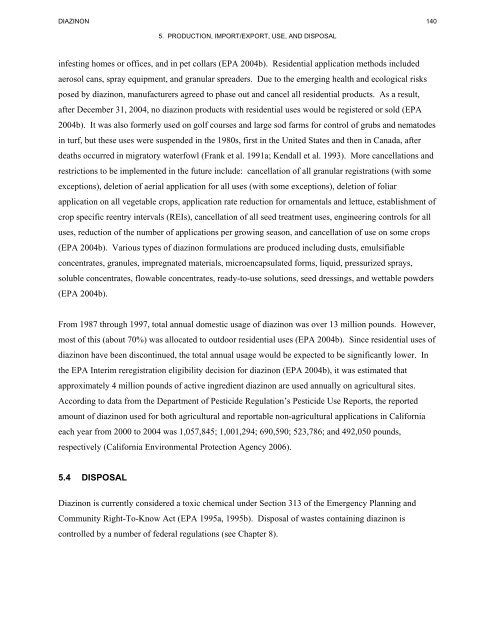Toxicological Profile for Diazinon
Toxicological Profile for Diazinon
Toxicological Profile for Diazinon
Create successful ePaper yourself
Turn your PDF publications into a flip-book with our unique Google optimized e-Paper software.
DIAZINON 140<br />
5. PRODUCTION, IMPORT/EXPORT, USE, AND DISPOSAL<br />
infesting homes or offices, and in pet collars (EPA 2004b). Residential application methods included<br />
aerosol cans, spray equipment, and granular spreaders. Due to the emerging health and ecological risks<br />
posed by diazinon, manufacturers agreed to phase out and cancel all residential products. As a result,<br />
after December 31, 2004, no diazinon products with residential uses would be registered or sold (EPA<br />
2004b). It was also <strong>for</strong>merly used on golf courses and large sod farms <strong>for</strong> control of grubs and nematodes<br />
in turf, but these uses were suspended in the 1980s, first in the United States and then in Canada, after<br />
deaths occurred in migratory waterfowl (Frank et al. 1991a; Kendall et al. 1993). More cancellations and<br />
restrictions to be implemented in the future include: cancellation of all granular registrations (with some<br />
exceptions), deletion of aerial application <strong>for</strong> all uses (with some exceptions), deletion of foliar<br />
application on all vegetable crops, application rate reduction <strong>for</strong> ornamentals and lettuce, establishment of<br />
crop specific reentry intervals (REIs), cancellation of all seed treatment uses, engineering controls <strong>for</strong> all<br />
uses, reduction of the number of applications per growing season, and cancellation of use on some crops<br />
(EPA 2004b). Various types of diazinon <strong>for</strong>mulations are produced including dusts, emulsifiable<br />
concentrates, granules, impregnated materials, microencapsulated <strong>for</strong>ms, liquid, pressurized sprays,<br />
soluble concentrates, flowable concentrates, ready-to-use solutions, seed dressings, and wettable powders<br />
(EPA 2004b).<br />
From 1987 through 1997, total annual domestic usage of diazinon was over 13 million pounds. However,<br />
most of this (about 70%) was allocated to outdoor residential uses (EPA 2004b). Since residential uses of<br />
diazinon have been discontinued, the total annual usage would be expected to be significantly lower. In<br />
the EPA Interim reregistration eligibility decision <strong>for</strong> diazinon (EPA 2004b), it was estimated that<br />
approximately 4 million pounds of active ingredient diazinon are used annually on agricultural sites.<br />
According to data from the Department of Pesticide Regulation’s Pesticide Use Reports, the reported<br />
amount of diazinon used <strong>for</strong> both agricultural and reportable non-agricultural applications in Cali<strong>for</strong>nia<br />
each year from 2000 to 2004 was 1,057,845; 1,001,294; 690,590; 523,786; and 492,050 pounds,<br />
respectively (Cali<strong>for</strong>nia Environmental Protection Agency 2006).<br />
5.4 DISPOSAL<br />
<strong>Diazinon</strong> is currently considered a toxic chemical under Section 313 of the Emergency Planning and<br />
Community Right-To-Know Act (EPA 1995a, 1995b). Disposal of wastes containing diazinon is<br />
controlled by a number of federal regulations (see Chapter 8).
















